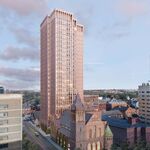M II A II R II K
Senior Member
Time To Accelerate Freeway Teardowns?
Sep 02 2010
By Neal Peirce
Read More: http://citiwire.net/post/2241/
Is America ready to tear down more of the elevated expressways that ripped through its cities in our post-World War II freeway building boom? It may well be. In New Orleans, there’s a concerted citizen-led campaign, backed by the national Congress for the New Urbanism (CNU), to demolish 2.2 miles of the elevated Interstate-10 Claiborne Expressway as it plows into the city from the northeast, past the French Quarter and ending near the Superdome.
- Old Claiborne Avenue, with its generous, oak-shaded median, a walkable neighborhood center with a history of picnics, Mardi Gras parades and black marching bands, literally disappeared under the broad new route that backers claimed would carry traffic and prosperity into downtown New Orleans. The number of businesses along the freeway’s path literally collapsed — from 132 in 1960 to 35 in 2000. Poverty and decay reigned, the stark expressway section creating a hostile no-man’s land around it.
- In Milwaukee, where Jon Norquist — then mayor, now CNU president — led the successful effort to dismantle the Park East Freeway, the bill for teardown and putting a surface street system in place was just $30 million, compared to $80 million to rebuild the freeway. In fact, teardowns, at least on unessential interstate links, may start looking more attractive nationally as the U.S. Department of Transportation struggles to come up with sufficient maintenance budgets to keep up the elevated freeways passing their effective 50-year lifespan point.
- The CNU position is that regular urban grids, minus the expressways, raise property values, increase mobility, restrain sprawl, and make for far more successful cities. The normal roadways foster, says Norquist, “compact, pedestrian-friendly and mixed-use neighborhoods with interconnected networks of streets†— a system that works well as space for drivers and pedestrians alike.
- Disasters took out two other famed freeways. The first was New York City’s West Side Highway, which experienced a catastrophic collapse in 1973 and was eventually replaced by a boulevard with a parallel river front bicycle path. And then, the 1989 Loma Prieta earthquake forced closure and led to eventual demolition of San Francisco’s Central Freeway. It would be hard to find many New Yorkers or San Franciscans who would want either expressway back.
Sep 02 2010
By Neal Peirce
Read More: http://citiwire.net/post/2241/
Is America ready to tear down more of the elevated expressways that ripped through its cities in our post-World War II freeway building boom? It may well be. In New Orleans, there’s a concerted citizen-led campaign, backed by the national Congress for the New Urbanism (CNU), to demolish 2.2 miles of the elevated Interstate-10 Claiborne Expressway as it plows into the city from the northeast, past the French Quarter and ending near the Superdome.
- Old Claiborne Avenue, with its generous, oak-shaded median, a walkable neighborhood center with a history of picnics, Mardi Gras parades and black marching bands, literally disappeared under the broad new route that backers claimed would carry traffic and prosperity into downtown New Orleans. The number of businesses along the freeway’s path literally collapsed — from 132 in 1960 to 35 in 2000. Poverty and decay reigned, the stark expressway section creating a hostile no-man’s land around it.
- In Milwaukee, where Jon Norquist — then mayor, now CNU president — led the successful effort to dismantle the Park East Freeway, the bill for teardown and putting a surface street system in place was just $30 million, compared to $80 million to rebuild the freeway. In fact, teardowns, at least on unessential interstate links, may start looking more attractive nationally as the U.S. Department of Transportation struggles to come up with sufficient maintenance budgets to keep up the elevated freeways passing their effective 50-year lifespan point.
- The CNU position is that regular urban grids, minus the expressways, raise property values, increase mobility, restrain sprawl, and make for far more successful cities. The normal roadways foster, says Norquist, “compact, pedestrian-friendly and mixed-use neighborhoods with interconnected networks of streets†— a system that works well as space for drivers and pedestrians alike.
- Disasters took out two other famed freeways. The first was New York City’s West Side Highway, which experienced a catastrophic collapse in 1973 and was eventually replaced by a boulevard with a parallel river front bicycle path. And then, the 1989 Loma Prieta earthquake forced closure and led to eventual demolition of San Francisco’s Central Freeway. It would be hard to find many New Yorkers or San Franciscans who would want either expressway back.
















